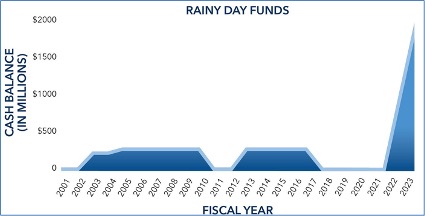Illinois’ Budget: The Big Picture
The General Assembly adjourned on May 26th, 2023, after enacting the FY24 budget, which largely reflects the priorities of the Governor’s proposed budget. Revenue growth seen during the COVID years has slowed, and the economy remains at some risk of recession. Yet, the State will end FY23 on June 30, 2023, and enter FY24 on July 1, 2023, in a strong fiscal position relative to its history. Reactions to the final budget from nonprofit sector stakeholders are generally tempered, for reasons explored in our analysis.
FY24 Revenue and Expenditures
Budget experts predict continued (but modest) increase in individual income tax growth in FY24 but a decrease in corporate income tax. The final budget is based on the bipartisan Commission on Government Forecasting and Accountability (COGFA) FY24 revenue forecast of $50.6 billion and approves FY24 General Fund expenditures of $50.4 billion, leaving a relatively small surplus of $183 million at the end of FY24. There are no sweeping statutory revenue changes; in fact, some of the household tax relief provided last year will expire in FY24. A handful of mostly private business-related tax provisions were contained in the revenue omnibus (SB1963), such as an increase in the exemption for businesses from the first $5,000 in liability under the corporate franchise tax, up from $1,000.
Debt, Budget Stabilization, and Pensions

(Chart Source: Comptroller’s Office)
Since FY22, the state paid down $10 billion in COVID-related and interfund borrowing debt, paid off the $4 billion+ Unemployment Insurance Trust Fund advance, made Pension Stabilization Fund contributions $700 million above the required level. Further, the state’s GDP surpassed $1 trillion. Additionally, the budget stabilization fund, commonly known as the Rainy-Day Fund, will have over $2 billion by the end of FY24. This progress is significant by IL standards, but not necessarily compared to other states. Illinois is more aligned with best practice in recent years, but with room yet for improvement.
Learn more: Compare states’ budget reserves Please note this comparison does not yet include FY23 deposits.
New Programs, Expansions and Key Changes
The FY24 budget includes several new and increased program appropriations; a roundup of key provisions are summarized below.
